- Home
- > Nature online
- > Life
- > Other invertebrates
- > British earthworms
Primary navigation
- Life
- Mammals
- Birds
- Reptiles, amphibians and fishes
- Insects and spiders
- Other invertebrates
- Blaschka models of marine invertebrates
- Discovery of North Sea marine worm
- Preparation of giant squid (video)
- Chinese mitten crabs
- British earthworms
- British earthworm survey
- Mite specimens: Get up close
- Mite CT scan
- The Echinoid Directory
- Specimen jar
- Land snail
- Woodlouse identification key
- Fate of coral reefs
- The secret life of barnacles
- Dinosaurs and other extinct creatures
- Plants and fungi
- Human evolution
British earthworms
Earthworms are great for soil. They speed up decomposition by consuming lots of dead plant material, and their burrows help aerate the soil and let water through easily. Worm casts (faeces) are rich in recycled plant nutrients that help to maintain soil fertility.
There are 27 species of earthworm living naturally in the British Isles. While more exotic species have been accidentally introduced, these are generally restricted to botanical gardens and commercial greenhouses.
View some of the more common British earthworms below.
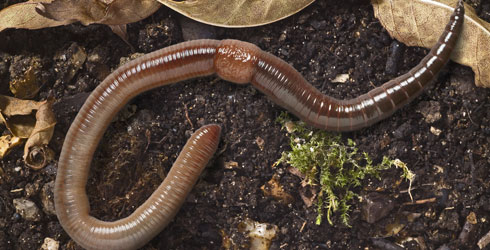
The lob worm, Lumbricus terrestris, is Britain's largest earthworm. The biggest individuals can be up to 35cm long when moving. They live in deep vertical burrows in the soil and can anchor themselves by broadening their tail to grip the sides of the burrow.
Lob worms emerge at night to feed on fallen leaves and other decaying plant material. There can be populations of 20 to 40 worms per square metre in an average garden lawn.
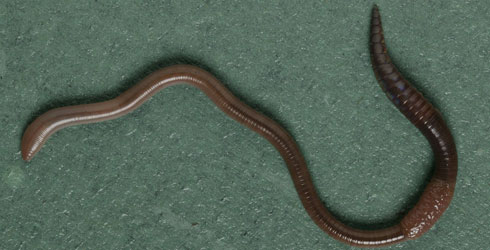
The black-headed worm, Aporrectodea longa, is moderately common (5 to 20 worms per square metre) in alkaline soils in open areas such as gardens, grassland and cultivated soils.
It is a large worm - up to 17cm long when moving. It lives in permanent burrows, unlike some species which don't maintain their tunnels. It can produce piles of worm casts or faeces, sometimes more than 5cm tall, around the entrance to its burrows.

The green worm, Allolobophora chlorotica, has a wide distribution and is often the most numerous earthworm in all but the most acid habitats.
It occurs in 2 different colour morphs, a muddy greenish yellowy colour, and a pale pinky colour. It grows to around 8cm long when moving, and can produce copious amounts of yellow fluid from pores along its body when disturbed.

The grey worm, Aporrectodea caliginosa, is a pale earthworm that is often easy to identify because of the different shades of colour along its body. There are usually 3 distinct shades at the front end of the worm. Adults typically grow to 6cm in length.
The grey worm is very common throughout the UK. It lives in non-permanent horizontal burrows in topsoil.
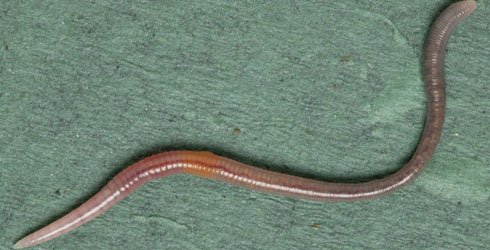
The rosy-tipped worm, Aporrectodea rosea, is widespread and can be found in the topsoil in most habitats. The typical size of an adult is 5cm.
This worm has a rosy pink or pale pink head, the saddle is usually orange, and there are often two or more whitish raised pads before the male pores. The body from the first segment to the saddle is entirely or partly pale in colour.
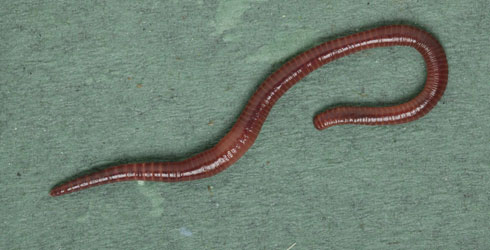
The brandling worm, Eisenia fetida, is usually found in garden compost but also occurs in wet, decaying leaf litter, organic-rich soils and manure heaps. It eats rotting vegetation.
This worm grows to around 6cm long. The whole body is stripy on its upper surface - it has dark red banks, with a narrower pale pink or yellowish band in between. The saddle is usually a similar colour to the rest of the body. It can exude an unpleasant-smelling yellowish fluid when handled.
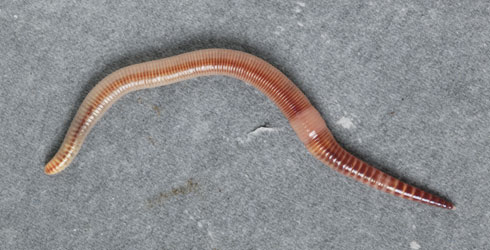
The compost worm, Eisenia veneta, is usually found in garden compost but can also occur in wet, decaying leaf litter, organic-rich soils and manure heaps. It eats rotting vegetation.
Adults grow to around 7cm. Their whole body is stripy on the upper surface when moving - it has dark red bands, with a pale pink or yellowish band in between. The saddle is usually paler than the rest of the body.
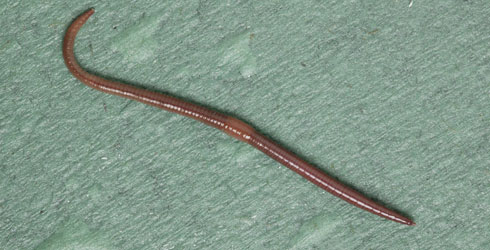
The chestnut worm, Lumbricus castaneus, is common and widespread, found in many habitats. It lives in leaf litter and under logs.
The typical size of an adult is 4cm. The upper surface of the body, from the first segment to the saddle, is entirely dark in colour (chestnut brown). A raised whitish gland is visible on the underside between the saddle and the head.

The redhead worm, Lumbricus rubellus, is a widespread species found in most habitats. It lives in the topsoil and leaf litter and is thought to feed on decaying leaf litter fragments.
The typical size of an adult is 6.5cm. The upper surface of the body, from the first segment to the saddle, is entirely dark in colour (reddish brown) and the worm sometimes flattens its tail into a paddle shape.
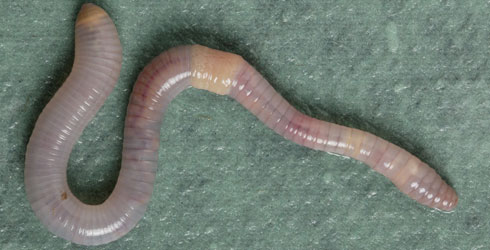
The blue-grey worm, Octolasion cyaneum, is found in pasture and arable land, gardens and woodlands. It lives in the topsoil.
The typical size of an adult is 10cm. The body from the first segment to the saddle is partly or entirely pale in colour. It can vary from faint blue-grey to a pale rosy pink colour with a distinct yellow tail (the last 4 or 5 segments). It may have a lilac blue line on the upper surface.
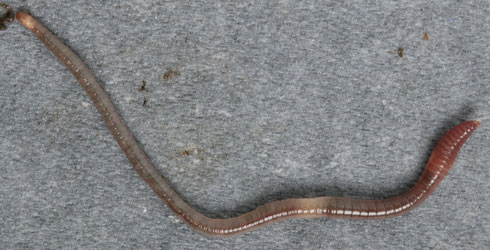
The octagonal-tailed worm, Dendrobaena octaedra, gets its name because the tail is octagonal in cross-section but this is difficult to see in live earthworms. The upper surface of the body, from the first segment to the saddle, is entirely dark in colour.
Adults grow to around 3cm and live in leaf litter.
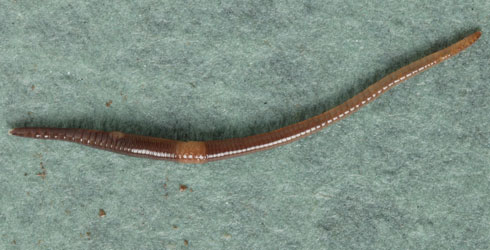
The little tree worm, Satchellius mammalis, is widespread in many habitats, from woodlands and field margins to marshy habitats and river banks, but seldom abundant. It lives in leaf litter.
It is very small - the typical size of an adult is 3cm. The upper surface of the body, from the first segment to the saddle, is entirely dark in colour.
Related information
- Monitoring climate change impact in the UK
- British earthworm survey - video
- Terrestrial invertebrates division
External links
Toolbox
- Contact and enquiries
- Accessibility
- Site map
- Website terms of use
- © The Trustees of the Natural History Museum, London
- Information about cookies
- Mobile